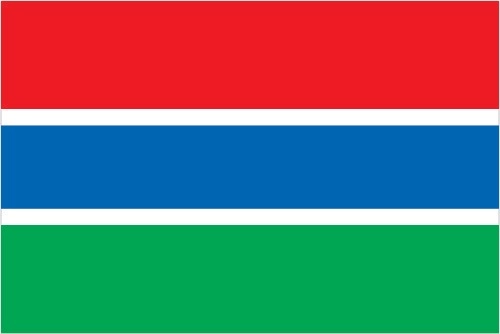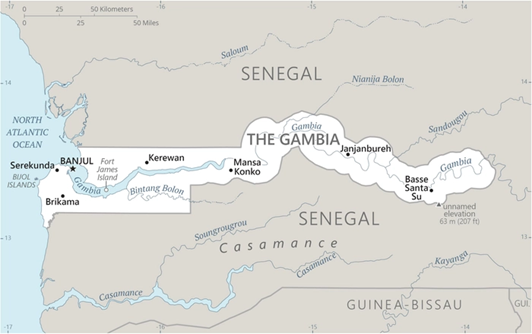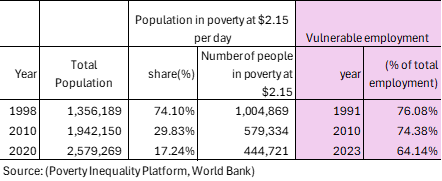
The Gambia
Country Flag Details three equal horizontal bands of red (top), blue with white edges, and green; red stands for the sun and the savannah, blue represents the Gambia River, and green symbolizes forests and agriculture; the white stripes denote unity and peace.
Background The Gambia gained its independence from
the UK in 1965. Joining Senegal, it formed a short-lived Confederation of Senegambia
between 1982 and 1989. Since its first free
and fair presidential election in 2016, The
Gambia and the US have enjoyed improved
relations.

Geography
Area
total: 11,300 sq km
land: 10,120 sq km
water: 1,180 sq km
Climate
tropical; hot, rainy season (June to
November); cooler, dry season (November to May)
Natural resources
fish, clay, silica sand, titanium (rutile and
ilmenite), tin, zircon
People and Society
Population
total: 2,523,327
Ethnic groups
Mandinka/Jahanka 33.3%,
Fulani/Tukulur/Lorobo 18.2%, Wolof 12.9%, Jola/Karoninka 11%, Serahuleh 7.2%, Serer 3.5%, other 4%, non-Gambian 9.9% (2019-20 est.)
Languages
English (official), Mandinka, Wolof, Fula,
other indigenous vernaculars
Religions Muslim 96.4%, Christian 3.5%, other or none 0.1% (2019-20 est.)
Population growth rate
2.16% (2024 est.)
Economy
Real GDP (purchasing power parity)
$7.911 billion (2023 est.)
$7.549 billion (2022 est.)
$7.156 billion (2021 est.)
Real GDP per capita
$2,900 (2023 est.)
$2,900 (2022 est.)
$2,800 (2021 est.)
Exports $643.689 million (2023 est.)
$267.377 million (2022 est.)
$142.652 million (2021 est.)
Exports – partners
Kazakhstan 92%, Guinea-Bissau 2%, China
1%, India 1%, Greece 1% (2023)
Exports – commodities
packaged medicine, cars, food items, raw material, metals, refined petroleum, mix of manufactured goods (2023)
Imports
$1.38 billion (2023 est.)
$829.516 million (2022 est.)
$726.23 million (2021 est.)
Imports – partners
Kazakhstan 26%, China 18%, Senegal 8%,
India 7%, Brazil 4% (2023)
Imports – commodities
crude petroleum, refined petroleum, cotton
fabric, iron alloys, rice (2023)

Export structure by product group in 2023 (% of total exxport)(UNCTAD)

Poverty and vulnerable employment (World Bank)
Understanding Poverty level significance at $2.15 per day
In 2020, 17 percent of the population in Gambia lived in poverty at $2.15 per day. The poverty level at $2.15 per day (measured in 2017 purchasing power parity, or PPP) is a key global benchmark used by the World Bank to define extreme poverty in low-income countries. It indicates:
1. Basic Survival Threshold
• People living below $2.15 per day struggle to afford essential needs such as food, clean water, shelter, healthcare, and education.
2. Economic Underdevelopment
• A high percentage of a country’s population living below this threshold suggests low economic productivity, high unemployment, and weak social safety nets.
3. Inequality and Social Vulnerability
• It reflects deep income inequality and a lack of access to opportunities for upward mobility.
• People in this category are more vulnerable to shocks like food price increases, climate disasters, or health crises.
4. Policy Challenges
• Governments need targeted interventions such as social welfare programs, job creation, and improved access to education and healthcare to reduce poverty.
A country's export structure is a reflection of its level of development and its productive capacities
The export structure of a country refers to the composition, diversity, and value of the goods and services it sells to other countries. It provides key insights into the country’s economic health, competitiveness, and level of development. Productive capacities of a country refer to its ability to produce goods and services efficiently and sustainably over time. These capacities are shaped by various factors, including human capital, natural resources, infrastructure, private sector, development, technology & innovation, institutions & governance, financial systems trade & market access.
Here’s what the export structure and productive capacities of a country typically indicate:
- Level of Economic Development
- Developed economies usually export high-value manufactured goods, technology, and services.
- Developing economies often rely on raw materials, agricultural products, or low-value manufactured goods.
- Industrial and Sectoral Strengths
- A strong presence of high-tech or industrial goods (e.g., machinery, electronics) suggests a well-developed manufacturing sector.
- A dominance of commodities (e.g., oil, minerals, agricultural products) indicates reliance on natural resources.
- Export Diversification
- A diverse export base (multiple industries) makes a country’s economy more stable and resilient to global price shocks.
- A concentrated export base (few key products) makes it vulnerable to market fluctuations.
- Trade Partnerships and Dependence
- If exports are heavily dependent on a single country or region, the economy is more exposed to geopolitical and trade risks.
- A wide range of trading partners indicates stronger global integration.
- Competitiveness and Value Addition
- Exporting mainly raw materials (e.g., crude oil instead of refined petroleum) suggests limited industrial processing capacity.
- A high share of finished and high-tech goods suggests strong value addition and competitiveness.
Gambia-Sanitation
Gambia – Proportion of population served with at least basic sanitation
In 2022, proportion of population served with at least basic sanitation for Gambia was 47.7%. Proportion of population served with at least basic sanitation of Gambia declined from 51.1% in 2000 to 47.7 % in 2022, an absolute change of 3.4 percentage points (pp) between 2000 and 2022.
Gambia – Proportion of urban population served with at least basic sanitation
In 2022, proportion of urban population served with at least basic sanitation for Gambia was 61.1 %. Proportion of urban population served with at least basic sanitation of Gambia increased from 42.5 % in 2000 to 61.1 % in 2022 an absolute change of 18.6 pp between 2000 and 2022.
Gambia – Proportion of rural population served with at least basic sanitation
In 2022, proportion of rural population served with at least basic sanitation for Gambia was 24 %. Proportion of rural population served with at least basic sanitation of Gambia decreased from 58.9 % in 2000 to 24 % in 2022, an absolute change of 34.9 pp between 2000 and 2022.
Gambia – Proportion of population served with at least basic sanitation (% of total population): A Global Perspective
The critical issue of inadequate sanitation poses a significant threat, resulting in the loss of hundreds of thousands of lives each year and exposing serious flaws in global public health systems. Access to safe sanitation is not simply a necessity; it is a fundamental human right that must be ensured for every individual. Alarmingly, in 2022, just 48 percent of Gambia’s population had access to adequate sanitation facilities. This troubling figure starkly contrasts with countries like Thailand and South Korea, where nearly the entire population enjoys basic sanitation services. Such disparities highlight the urgent need for collective action to enhance sanitation resources in nations like Gambia, thereby protecting public health and well-being.

Gambia – Proportion of rural population served with at least basic sanitation (% of rural population): A Global Perspective
Between 2000 and 2022, the percentage of the rural population in Gambia with access to basic sanitation witnessed a sharp decline, plummeting from 58.9 percent to a mere 24 percent, which reveals a deeply troubling deterioration in sanitary conditions that affects the health and well-being of its citizens. In stark contrast, Vietnam has achieved remarkable success, significantly boosting access to sanitation facilities among its rural populace, with the percentage soaring from 40.3 percent in 2000 to an impressive 88.4 percent by 2022. This marked disparity not only highlights the critical challenges faced in Gambia and broader Sub-Saharan Africa but also emphasizes the urgent need for transformative changes in sanitation access. It underscores the critical importance of immediate and collective action to address this pressing issue, ensuring that all communities can enjoy the fundamental right to safe and hygienic sanitation.

Gambia-Water Supply
Gambia – Proportion of total population served with at least basic drinking water
In 2022, proportion of population served with at least basic water for Gambia was 85.6 %. Proportion of population served with at least basic water of Gambia increased from 72.1 % in 2000 to 85.6 % in 2022, an absolute change of 13.5 pp between 2000 and 2022
Gambia – Proportion of urban population served with at least basic drinking water
In 2022, proportion of urban population served with at least basic water for Gambia was 90.9 %. Proportion of urban population served with at least basic water of Gambia increased from 82.2 % in 2000 to 90.9 % in 2022, an absolute change of 8.7 pp between 2000 and 2022.
Gambia – Proportion of rural population with at least basic water
In 2022, proportion of rural population served with at least basic water for Gambia was 76.4 %. Proportion of rural population served with at least basic water of Gambia increased from 62.8% in 2003 to 76.4 % in 2022, an absolute change of 13.6pp between 2000 and 2022.
Gambia – Proportion of total population served with at least basic water: A Global Perspective
Access to safe drinking water is not only crucial for survival; it stands as a fundamental human right that should be guaranteed to every individual, regardless of their circumstances. In 2022, approximately 85.6% of Gambians had reliable access to at least basic drinking water, which starkly contrasts with the near-universal access enjoyed by the populations of Thailand and South Korea. This striking disparity emphasizes the pressing need for extensive reforms and improvements in water accessibility across Sub-Saharan Africa, where millions still grapple with the daily struggle to obtain this essential resource. Ensuring equitable access to safe drinking water is vital for not only enhancing public health but also fostering economic development and improving the overall quality of life for communities in this region.

Gambia – Proportion of rural population with at least basic water: A Global Perspective
In 2022, 76.4 percent of the rural population in Gambia had access to basic drinking water, a concerning statistic when viewed in the context of other nations. For instance, Thailand achieves an impressive 100 percent access for its rural residents, while China and Vietnam report access rates of 96 percent and 97 percent, respectively. These stark contrasts emphasize the critical need for enhanced water security in Gambia and underscore the larger global challenge of ensuring that every individual, no matter where they live, can access safe and reliable drinking water, which is a fundamental human right that remains elusive for many.

Gambia-Access to Electricity
Gambia-Access to Electricity (% of population)
In 2022, proportion of population with access to electricity for Gambia was 65.4 %. The proportion of population with access to electricity of Gambia increased from 34.3% in 2000 to 65.4% in 2022, an absolute change of 31.1 pp between 2000 and 2022.
Gambia-Access to electricity (% urban population)
In 2022, proportion of urban population with access to electricity for Gambia was 82.8%. The proportion of urban population with access to electricity of Gambia increased from 51.2% % in 2000 to 82.8% in 2022, an absolute change of 31.6 pp between 2000 and 2022.
Gambia-Access to electricity (% rural population)
In 2022, proportion of rural population with access to electricity for Gambia was 31.2 %. The proportion of rural population with access to electricity of Gambia increased from 18.8 % % in 2000 to 31.2% in 2022, an absolute change of 12.4 pp between 2000 and 2022.
Gambia-Access to electricity (% of population): A Global Perspective
In 2022, Gambia’s electricity access rate stood at 65.4 percent, revealing a troubling reality where an alarming 35 percent of the population remains without this vital service that is crucial for everyday life. This urgent situation calls for immediate intervention, especially when we look at the remarkable achievements of countries such as Vietnam, Sri Lanka, and Indonesia, which all reached an impressive 100 percent electricity access in the same year. These stark contrasts underscore the critical need for a comprehensive reassessment of Gambia’s energy policies and infrastructure, as the gap in electricity access not only reflects disparities in development but also highlights an opportunity for transformative change. Improving access to reliable electricity is not just a luxury, it is an essential driver for sustainable socio-economic development, serving as the backbone for education, healthcare, and economic activities that can uplift the entire nation.

Gambia-Access to electricity (% of rural population): A Global Perspective
The data reveals a significant disparity in electricity access between Gambia and other developing nations, emphasizing the urgent need for comprehensive improvements in energy infrastructure. In 2022, only 31.2 percent of the rural population in Gambia had access to electricity, which signals ongoing developmental challenges that require immediate attention and action. In stark contrast, nations such as Vietnam, Thailand, and Sri Lanka achieved an impressive milestone of 100 percent electricity access for their rural areas during the same period. This glaring discrepancy not only highlights the pressing necessity for enhanced energy solutions in Gambia but also underscores the fundamental role that a reliable electricity supply plays in driving sustainable development and improving living standards for rural communities, ultimately fostering economic growth and social progress.

Gambia-Health Outcomes
Gambia-Life expectancy: A Global Perspective
Over the past 70 years, global life expectancy has seen remarkable improvements, with people living longer than ever before due to advancements in healthcare, nutrition, and overall living conditions. In 1950, the average life expectancy for newborns worldwide was only 47 years; however, by 2021, this figure had risen significantly to 71 years, reflecting the progress made globally. Despite this positive trend, many countries in Sub-Saharan Africa have experienced only modest gains in life expectancy. For instance, in Gambia, life expectancy increased from 35 years in 1960 to 63 years in 2022, illustrating the challenges that remain. In stark contrast, South Korea celebrated an extraordinary rise in life expectancy, which soared from a mere 21 years in 1950 to an impressive 84 years in 2022, showcasing the benefits of dedicated public health initiatives and economic development. Similarly, the Maldives also witnessed significant progress, with life expectancy climbing from 47 years in 1960 to 66 years in 2022, as highlighted in the accompanying chart.

Gambia- Mortality rates, under-5( per 1000 live births): A Global Perspective
Since 1950, a remarkable decline in global child mortality rates has been observed, driven by significant advancements in living conditions, healthcare accessibility, nutrition, and the availability of clean drinking water. In the affluent regions of Europe and America, child mortality has impressively dropped to below four percent, a testament to the effectiveness of systemic improvements in public health. Over the past seven decades, various developing nations across South America, Asia, and Africa have made tangible progress; however, it is disheartening to note that the pace of improvement has remained disappointingly slow in many Sub-Saharan African countries. For instance, Gambia’s child mortality rate, which stood at a staggering 230 in 1980, has seen a significant reduction to 46 in 2022. In contrast, Bangladesh witnessed an impressive decline from 206 to 29 during the same time frame, while India reported a similar decrease from 169 to 29, underscoring the critical need for transformative changes in Sub-Saharan Africa, ensuring that every child is afforded the opportunity to thrive and reach their full potential.

Gambia- maternal mortality ration (per 100,000 per live births): A Global Perspective
In the chart provided, we illustrate the annual instances of pregnancy-related fatalities across diverse regions and countries, highlighting a stark reality: the majority of these tragic deaths occur within Sub-Saharan Africa. This alarming trend is driven not only by the significantly higher number of births in this region but also by profoundly elevated maternal mortality rates, which reflect the ongoing challenges faced by healthcare systems. Notably, in Gambia, the total maternal deaths have seen a commendable decline from 778 in the year 2000 to 458 in 2022, indicating progress in maternal health initiatives. Similarly, Bangladesh has achieved a substantial reduction in its maternal mortality ratio, decreasing from 441 in 2000 to an encouraging 123 in 2022, while India has also made significant strides, with figures dropping from 384 in 2000 to 103 in 2022. These statistics not only illustrate progress but also underscore the urgent need for continued efforts to improve maternal health across all regions. Furthermore, understanding the intricacies of these trends emphasizes the importance of targeted interventions and the allocation of resources to ensure that every woman has access to safe childbirth, ultimately contributing to the global commitment to maternal health and sustainable development.
